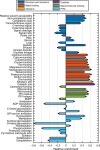Inferring the molecular and phenotypic impact of amino acid variants with MutPred2
- PMID: 33219223
- PMCID: PMC7680112
- DOI: 10.1038/s41467-020-19669-x
Inferring the molecular and phenotypic impact of amino acid variants with MutPred2
Abstract
Identifying pathogenic variants and underlying functional alterations is challenging. To this end, we introduce MutPred2, a tool that improves the prioritization of pathogenic amino acid substitutions over existing methods, generates molecular mechanisms potentially causative of disease, and returns interpretable pathogenicity score distributions on individual genomes. Whilst its prioritization performance is state-of-the-art, a distinguishing feature of MutPred2 is the probabilistic modeling of variant impact on specific aspects of protein structure and function that can serve to guide experimental studies of phenotype-altering variants. We demonstrate the utility of MutPred2 in the identification of the structural and functional mutational signatures relevant to Mendelian disorders and the prioritization of de novo mutations associated with complex neurodevelopmental disorders. We then experimentally validate the functional impact of several variants identified in patients with such disorders. We argue that mechanism-driven studies of human inherited disease have the potential to significantly accelerate the discovery of clinically actionable variants.
Conflict of interest statement
The authors declare the following competing interests. D.N.C. and M.M. acknowledge Qiagen Inc. for their financial support through a License Agreement with Cardiff University. The remaining authors declare no competing interests.
Figures




References
Publication types
MeSH terms
Substances
Grants and funding
LinkOut - more resources
Full Text Sources
Other Literature Sources

